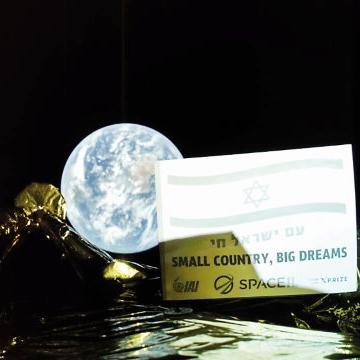
Featured Item

Jews out in space
HOWARD SACKSTEIN
Not so joyous, however, were the engineers at the Beresheet moon landing’s mission control centre, as they watched Israel’s first spacecraft crash-land on the moon’s surface. Its main engines failed a mere few kilometres from the “Sea of Serenity” on the light side of the moon last Thursday evening.
After a 6.5 million kilometre journey and about 150m above the moon’s surface, communication with Beresheet went dark. Engineers at SpaceIL believe that the device which measured Beresheet’s altitude from its landing site failed, triggering a chain reaction that caused the main engines of the spacecraft to stop firing.
With the main engines gone, there was no mechanism to slow the descent of Beresheet to the moon’s surface. Descending at 500km/h, a collision with the lunar surface was “inevitable”, according to a spokeswoman for the Beresheet team.
US Apollo 11 mission astronaut and second man on the moon, Buzz Aldrin, tweeted, “Condolences to the Beresheet lander @TeamSpaceIL for what almost was! Communications were lost with the spacecraft just 150 meters (!!!) above the surface, and it couldn’t quite stick the landing. Never lose hope – your hard work, team work, and innovation is inspiring to all!”
Now lying in pieces on the face of the moon is a microchip carried by the Beresheet moon lander containing the names and faces of the Schusterman Foundation Fellows, including South African Guy Lieberman.
The main promoter of the Beresheet project was South African, Benoni born businessman, and philanthropist, Morris Kahn, who provided at least $40 million (R557 million) to kick-start the project. “We didn’t make it, but we definitely tried, and I think the achievement of getting to where we got is pretty tremendous,” Kahn, said during a livestream of the attempt.
Within two days of the crash-landing, Kahn was launching project Beresheet 2. Appearing on Israeli TV, he said, “We started something and we need to finish it. We’ll put our flag on the moon. Project Beresheet 2 begins tomorrow… A mission team will be meeting tomorrow to start work.”
Before plummeting to its ultimate demise, Beresheet sent back to earth its final “selfie” picture, a photo of the moon’s surface silhouetted against an Israeli flag, with the words inscribed “small country big dreams”.
Beresheet was the first privately funded mission to the moon. The project was a joint venture between the Israeli non-profit SpaceIL and Israel Aerospace Industries. It was funded by private donations from, among others, Kahn, the founder of Israeli telecommunications billing company Amdocs, casino moguls Miriam and Sheldon Adelson, and oil tycoon Lynn Schusterman.
Kahn who was actively involved in Habonim before leaving South Africa in 1956, was adamant that, “This is also a good lesson for the youth. I said that if you fail, you need to get up and try again, and this is an example I have to give them.”
While Beresheet was Israel’s first attempt to land safely on the moon, Jews have always featured prominently in missions to space.
On 1 February 2003, 16 minutes before its scheduled landing, the American Space Shuttle Columbia exploded over eastern Texas on re-entry into the earth’s atmosphere. On board was Israel’s first astronaut, Ilan Ramon, who died as the Shuttle disintegrated into pieces. At age 48, Ramon was the oldest member of the seven-member crew.
The son of a Holocaust survivor, Ramon had taken with him into space a tiny Torah scroll given to him by Israeli President Moshe Katsav and a pencil sketch, Moon Landscape, drawn by 16-year-old Petr Ginz, who died in Auschwitz.
Also among Ramon’s personal items on the doomed mission, were a barbed wire mezuzah by San Francisco artist Aimee Golant, and a dollar note from the Lubavitcher Rebbe, Rabbi Menachem M. Schneerson.
The first Jewish woman astronaut, Judith Resnik, also perished when the Space Shuttle Challenger exploded on take-off from Cape Canaveral on 28 January 1986.
In total, 14 Jewish astronauts have been to space, including Russian Cosmonaut Boris Volynov who travelled on the Soyuz 5 and Soyuz 21 missions for the Soviet Union.
Both missions were plagued by technical difficulties, reinforcing the message of Israeli mission control that, “space is hard”.
The first Jewish American male astronaut was Jeffrey A. Hoffman, who flew five Space Shuttle missions between 1985 and 1996. Besides Resnick, there have been two additional American Jewish women astronauts, Ellen S. Baker and Marsha Ivins, who flew eight Space Shuttle missions between them.
Other Jewish astronauts include Jerome Apt, David Wolf, Martin Fettman, John Grunsfeld, Scott Horowitz, Mark Polansky, Garett Reisman, and Gregory Chamitoff.
Chamitoff spent six months aboard the International Space Station across Expedition 17 and 18 in 2008, and another 15 days as part of STS-134 in 2011.
As part of his personal allowance, Chamitoff brought with him the first ever bagels into space: 18 sesame seed bagels brought from his cousin’s Fairmount Bagels bakery.
As Project Beresheet 2 gets off the ground, the Jewish stamp on space travel will get bolder and stronger.




